![[Celestial Globe on the Brazilian
Flag]](../images/b/br_globe.gif)

Last modified: 2019-01-01 by ian macdonald
Keywords: star (white) | star: 5 points | globe | southern cross | cruzeiro | astronomy |
Links: FOTW homepage |
search |
disclaimer and copyright |
write us |
mirrors
Unlike the stars on the American flag, each particular star on the Brazilian flag represents one particular state. All stars are actually present in the night sky, which is depicted as if seen from above (i.e. from outside the illusory 'globe' that the night sky appears to be when seen from Earth), and positioned as they would have been on 15 November 1889 at 08:30 over Rio de Janeiro. There are 5 orders of magnitude (.30, .25, .20, .14 and .10 times 1/14 of the width of the flag respectively). These magnitudes do not directly correspond to the astronomical magnitudes, but are relative to them. (The stars are identified by color on the image to their right -- these colors do not correspond to their real color, either astronomically or on the flag)
| State | Star | Constellation | Size | |
|---|---|---|---|---|
| Amazonas | Alpha Canis Minoris (Procyon) | Canis Minor, the Lesser Dog | 1 | 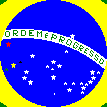 |
| Mato Grosso | Alpha Canis Majoris (Sirius) | Canis Major, the Greater Dog | 1 | |
| Amapá | Beta Canis Majoris (Mirzam) | Canis Major, the Greater Dog | 2 | |
| Rondônia | Gamma Canis Majoris (Muliphein) | Canis Major, the Greater Dog | 4 | |
| Roraima | Delta Canis Majoris (Wezen) | Canis Major, the Greater Dog | 2 |  |
| Tocantins | Epsilon Canis Majoris (Adhara) | Canis Major, the Greater Dog | 2 | |
| Pará | Alpha Virginis (Spica) | Virgo, the Virgin | 1 | |
| Piauí | Alpha Scorpii (Antares) | Scorpius, the Scorpion | 1 | |
| Maranhão | Beta Scorpii (Graffias) | Scorpius, the Scorpion | 3 | 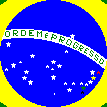 |
| Ceará | Epsilon Scorpii (Larawag) | Scorpius, the Scorpion | 2 | |
| Alagoas | Theta Scorpii (Sargas) | Scorpius, the Scorpion | 2 | |
| Sergipe | Iota Scorpii | Scorpius, the Scorpion | 3 | |
| Paraíba | Kappa Scorpii (Girtab) | Scorpius, the Scorpion | 3 | 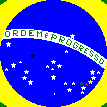 |
| Rio Grande do Norte | Lambda Scorpii (Shaula) | Scorpius, the Scorpion | 2 | |
| Pernambuco | Mu Scorpii (Xamidimura) | Scorpius, the Scorpion | 3 | |
| Mato Grosso do Sul | Alpha Hydrae (Alphard) | Hydra, the Water Serpent | 2 | |
| Acre | Gamma Hydrae | Hydra, the Water Serpent | 3 | 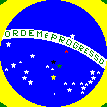 |
| São Paulo | Alpha Crucis (Acrux) | Crux, the Southern Cross | 1 | |
| Rio de Janeiro | Beta Crucis (Becrux) | Crux, the Southern Cross | 2 | |
| Bahia | Gamma Crucis (Gacrux) | Crux, the Southern Cross | 2 | |
| Minas Gerais | Delta Crucis | Crux, the Southern Cross | 3 |  |
| Espírito Santo | Epsilon Crucis (Gina) | Crux, the Southern Cross | 4 | |
| Rio Grande do Sul | Alpha Trianguli Australis (Atria) | Triangulum Australe, the Southern Triangle | 2 | |
| Santa Catarina | Beta Trianguli Australis | Triangulum Australis, the Southern Triangle | 3 | |
| Paraná | Gamma Trianguli Australis | Triangulum Australe, the Southern Triangle | 3 | 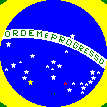 |
| Goiás | Alpha Carinae (Canopus) | Carina, the Keel of Argo | 1 | |
| Territory | Star | Constellation | Size | |
| Distrito Federal | Sigma Octantis (Polaris Australis) | Octans, the Octant | 5 |
Data from original annex to Brazilian Law (in Portuguese)
Herman De Wael, 20 January 1998
Star and constellation names translated into scientific and English (and some star names added) by Kjell Roll Elgsaas , 22 January 1998
Some time ago, someone in Brazil wrote to Flags of the World to say that Herman de Wael's
statement that the stars on
the Brazilian flag represent the sky as it was above Rio de Janeiro at 20:30 (i.e., 8:30 in the evening)
on 15 November 1889 was incorrect. [This statement has since been corrected, above--Ed.]
The writer stated that the time was correctly 08:30 (i.e., in the morning).
An
article in Portuguese by a Brazilian astronomer, Professor Paulo Araújo Duarte of the
Federal University of Santa Catarina, bears this out, saying "In truth, the creators
of our republican flag intended to represent the stars in the sky at Rio de
Janeiro at 8:30 in the morning on 15 November 1889, the moment at which the
constellation of the Southern Cross was on the meridian of Rio de Janeiro
and the longer arm [of the cross] was vertical." Another article,
citing "O Céu da Bandeira (The Sky of the Flag)" by J. R. V. Costa says the precise hour was actually 08:37.
This last article is one of the best overall discussions of the history of the
Brazilian flag anywhere; it includes the designer of the flag's
explanation of his intentions, at least regarding the stars.
Joseph McMillan, 2 August 2002
My original thought was the same as Jaume's--who would put the stars
on the flag as seen at a time of day when they couldn't be seen?
(And I don't believe there is any time of year when the stars are
visible over Rio at 8:30 in the morning.) However, Jorge Candeias has made clear that the
expression no dia in this context in the legislation means "in the morning."
It now seems to me that there are three pieces of evidence, each
strong in its own right and collectively conclusive, that the stars
on the Brazilian flag are intended to represent the sky over Rio at
8:30 a.m. on 15 November 1889, not at 8:30 p.m. (20:30) that evening:
I think that's indeed the more likely possibility. It could also be a
post-factum thing: since an upright Cruzeiro makes a better symbol than a
Cruzeiro in some other position, it was adopted without further thought.
Later on, after being asked repeatedly about the meaning of the symbol,
someone cooked up that explanation as a fancy way to keep meaning-buffs
happy.
Jorge Candeias, 5 August 2002
This has happened: when Brasilia was created, the previous Capital Territory
was changed into the state of Guanabara, and a star was added. Some years later,
that state was abolished again (and merged into RiodJ), but the star remained on
the flag. In fact, this is somewhat of a mystery. Anyway, the Brazilians seem
not to have changed their flag as often as they created new states. Although
recently, they have been diligent and I suppose they will be again [for any
future change].
Herman De Wael, 7 January 2012
Regarding the flag changes in Brazil, considering the stars, I believe a quote from the article by Tomislav Šipek from "Grb i zastava" is due:
"The number of stars was changed three times since 1889 [when 21 star flag was introduced, note ŽH]. The first change was made in July 1960, when the Federal District was moved from Rio de Janeiro to the newly established capital of Brasília, and when the state of Guanabara (the region of Rio de Janeiro excluding the city) was established. The number was increased to 22. The second update was made relatively soon afterwards, on 28 May 1968. The Law nr. 5443 added another star. The third change was on 11 May 1992. The Law nr. 8421 added yet another 4 stars. It should be noted that the increase of the number of stars in the flag was not contemporary with the establishment of the states, since Acre became a state in 1962 and got “its own” star only 6 years latter.
In the period between 1968 and 1992 there were other significant changes. The states of Guanabara and Rio de Janeiro were united into single state of Rio de Janeiro in 1975; in 1979 Mato Grosso do Sul was created by separation from Mato Grosso; Rondônia receives the statehood in 1982, and in 1989 Toncantins was seceded from Goiás. Finally in 1991 the statehood was achieved by Amapá and Roraima. In whole this period there was no change in the national flag even if the number of states was decreasing and increasing within Brazil.
(Tomislav Šipek: "120 godina nacionalne zastave i grba Brazila | 120th anniversary of the flag and the coat of arms of Brazil", Grb i zastava, nr. 6, studeni/November 2009, pp.12-15.)
Željko Heimer, 9 January 2012
Bandeira de Navegantes (“Helmsmen's flag”) by Nuno Crato, in Camões:
Revista de Letras e Culturas Lusófonas 8 (2000.01-03): p.86-92 (28×24
cm). Publ. by Instituto Camões. ISSN 0874-3029; Dep. leg.: 124734/99.
A Bandeira do Brazil: Raízes Históricas e Culturais (Brazil’s flag:
Historical and Cultural Roots) book by Raimundo Olavo Coimbra: Fundação
I.G.B.E.: Rio de Janeiro, 1972.
Armas, Brasões e Símbolos Nacionais
(National coats of arms and symbols) book by Sebastião Ferrarini: Edições
Curitiba: Curitiba, 1983.
Os Símbolos Nacionais (National Symbols)
book by Milton Fortuna Luz: Secretariado de Imprensa e Divulgação da Presidência
da República: Brasília, 1986.